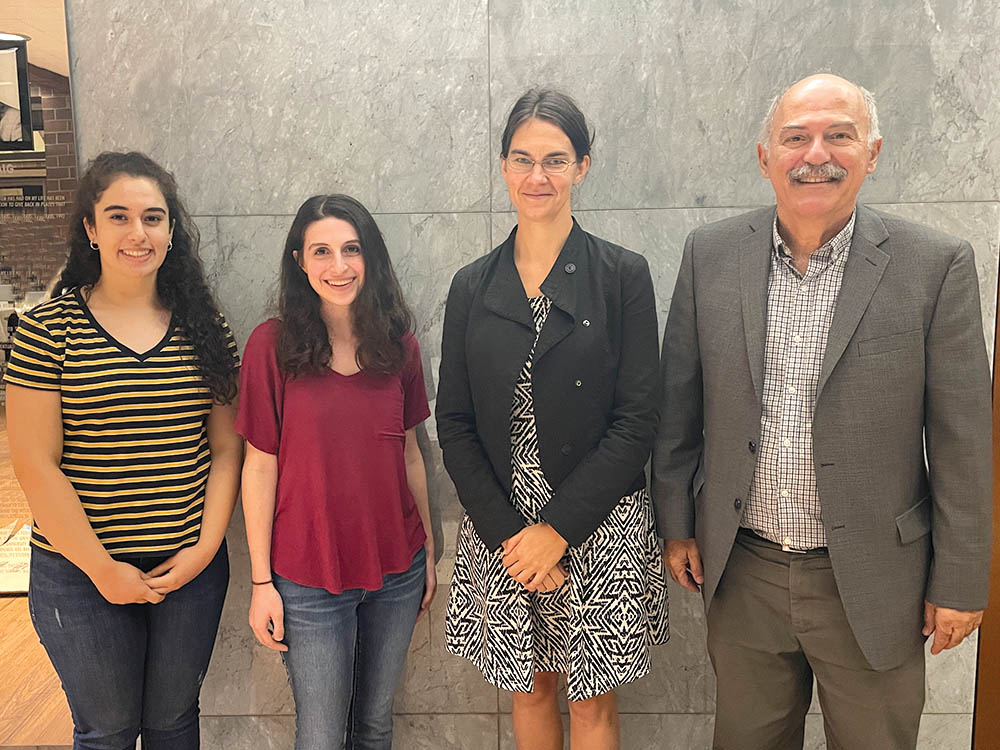
Photo: Andrew Hagopian
Careen Derkalousdian
Staff Writer
“We don’t write these histories from the women’s perspective. These histories don’t allow us to understand how Armenian women experienced being snatched or given up or taken in,” said Dr. Rebecca Jinks. “It doesn’t allow us to understand how they dealt with the violence, the uncertainty, the isolation, and the dependence on their host families. It’s a kind of detached history that we have been writing so far.”
On Thursday, September 15, 2022, Dr. Rebecca Jinks from Royal Holloway, University of London, presented a lecture on “‘And My Mother Gave Me Away’: Armenian Women Survivors’ Stories of ‘Absorption’ and Reintegration During and After Genocide.”
Dr. Jinks’s research is on the women who were “absorbed” into Turkish, Kurdish, and Arab families, and the variety of traumatic experiences they experienced.
Dr. Jinks began her lecture by giving an introduction to the topic of “absorption” of Armenian women during and after the Armenian Genocide. She referenced historian Ara Sarafian, who argues that there are four ways in which women were “absorbed.” These include families “choosing” religious conversion, being selected by Turkish government officials, being taken by local Turks, Kurds, and Arabs, and being placed into an orphanage system that sought to Turkify Armenian children.
According to Dr. Jinks, around 100,000 to 200,000 Armenians were absorbed during the Genocide, of which an estimated tens of thousands rejoined the Armenian community after the 1918 Armistice.
In addition, as Dr. Jinks points out, the perspective of these women is often lost in the telling of their absorption – it appears detached. This is due to the lack of memoirs that exist regarding these women’s experiences, so their stories are told in a broader historical context and their individual perspectives are lost.
There are also taboos surrounding absorption, particularly regarding instances of rape and forced religious conversion. Because of these taboos, the memoirs written by “absorbed” women often contain “silences.” In other words, they do not reveal the full extent of their suffering for fear of feeling shamed. According to Dr. Jinks, this is why it is just as important to pay attention to what is not said in addition to what is said in a memoir.
Siranouche Husnian, inter-viewed in 1985, and whose oral history is part of the Richard G. Hovannisian Armenian Collect-ion at the University of Southern California (USC), said “They treat me one of them. They treat me just one of them. They used to feel sorry for me. And they had an old lady in the house…and she used to take me in her lap and hug me and kiss me. She used to say whoever did this to you, God will punish them…She used to say that in Arabic. At first I couldn’t understand but later I understood what she said.”
This quote demonstrates how Siranouche slowly became absorbed into Arab culture, even adopting the Arab language. In this way, many women who were “absorbed” lost their Armenian identity.
Dr. Jinks states that absorption functioned as a method of genocide and made sure that people felt endangered by having an Armenian identity.
This uncertainty of survival and fear of accepting their Armenian identity forced victims to remain with their host families and prevented some from returning to Armenia when people started to reintegrate into Armenian society. In this way, many viewed absorption as inevitable.
Dr. Jinks pointed out that the moment these women were taken and isolated from their families is often told very simply in firsthand accounts such as interviews.
A recurring phrase used by survivors that represents this intense moment is being “taken by the hand.”
Although a simple phrase, it symbolizes the moment that these women became helpless and were ripped away from their families by their new host.
Dr. Jinks’ is in the early stages of research project called “Genocidal captivity: (Re)telling the Stories of Armenian and Yezidi Women Survivors of Genocide,” funded by the Arts and Humanities Research Council of the United Kingdom. The purpose of the project is to compare the absorption of Armenian women into Turkish, Kurdish, and Arab households in 1915 with that of Yezidi women abducted by ISIS into sexual slavery in 2014.
She hopes to gather more firsthand accounts of “absorbed” women so that their stories are no longer told in a detached manner. She wants to better understand these women’s perspectives so that their tragic stories are not forgotten.
 Hye Sharzhoom Armenian Action
Hye Sharzhoom Armenian Action